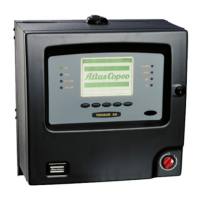Sync
182 (428) 9836 3123 01
Synchronization during the final tightening.
13.1 Sync prerequisites and limitations
A Sync group consists of two to ten PF units. The SynchroTork option is limited to six tools.
All Sync members must be part of the same cell, but a cell can consist of more than one Sync group. The
cell reference does not have to be a member of the Sync group. For creating a cell, see section Controller.
All Sync members must have the same Sync reference.
All Sync members must be connected via the internal I/O-bus, which is used for time critical
Synchronization communication. Do not connect two Sync groups via the I/O-bus.
The Sync reference can control external I/O bus units, such as RE-Alarm, Socket Selector and I/O
Expander.
All Psets must be configured from the Sync reference.
Do not configure any external I/O devices (device 1-15) on the Sync members.
No I/O bus cable connection is allowed from any of the sync group members to a non-sync group member
PF unit.
Ethernet communication is used for non-time critical communication such as start-up time,
creating/updating Psets and Multistages and transferring result data between the Sync reference and the
Sync members.
To be able to use Sync start, the 4-pin remote start connector on the Power Focus back panel must be
configured for remote start.
If a sync group is used for loosening the entire group will be classified as OK when at least one sync
member performs a successful loosening.
In a Synchronized application, the Sync communication has top priority on the I/O bus
when the tools are running. For that reason tool start, tool disable and other safety critical
functions must not be connected to the I/O bus via I/O Expander.
For a description of how to do Sync motor tuning, see section Tool.

